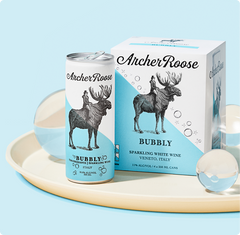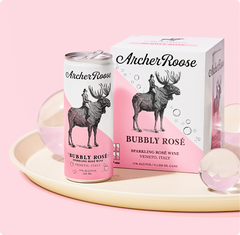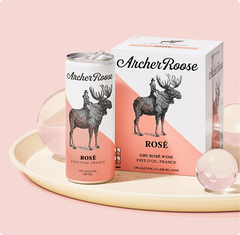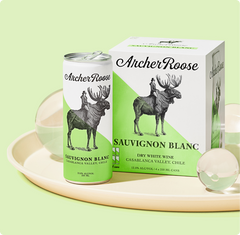FAQ | Luxury Canned Wines | Archer Roose

Browse by topic:
my order
After you’ve successfully checked out, we will send you an order confirmation email, which will have your order number in it. Or, go to archerroose.com/account and sign into your Archer Roose account to see your order history, including the order numbers.
Once your order has been prepared for shipping or has shipped, we are unable to cancel, make any changes to the items in your order, or alter the delivery address.
You can see all of the delivery addresses you’ve used by signing into your Archer Roose account: archerroose.com/account.
You will receive a confirmation email once Archer Roose receives your order. In that email, click View Your Order to track the status. Once your order ships, we will send you a shipment confirmation email with the UPS tracking number for your order. Track the status of your shipment using the UPS tracking number on ups.com/track.
Please inspect your order as soon as you receive it. If an item is damaged or if you receive the wrong product, contact us immediately at hello@archerroose.com, so that we can evaluate the problem and make it right.
shipping returns

For orders less than $99, we charge a flat $10 shipping fee. Orders over $99 will ship for free — simply choose the Free Shipping option at checkout.
Depending on where you live, your libations should arrive at your door just two to seven days after your order is placed. It’s rare, but, the pandemic or extreme weather events may cause local delays in shipping. Be sure to keep an eye on your tracking to follow your wine’s journey!
Yes. US laws require an adult aged 21 or older to sign for the delivery, as wine is an alcoholic beverage. Please make sure an adult will be present on the day your order arrives to receive it. We’d hate to see your cracking open a can of Archer Roose be delayed!
If you’re unable to sign for the delivery, UPS My Choice members can redirect the package to a UPS customer center or another location where someone can sign on your behalf. Unfortunately, you cannot sign online for delivery release as an adult signature is needed.
If you’ve already missed the delivery, you can sign the back of the UPS InfoNotice® slip and place it back where the driver left it.
Archer Roose ships to most contiguous states in the US, and we’re working to add more states soon. We currently are not able to ship directly to: Alabama, Delaware, Mississippi, Rhode Island, South Dakota or Utah. However, if you’re in Alabama, Delaware or Rhode Island, you can find Archer Roose at a store, bar or restaurant near you.
We are currently unable to ship internationally, but hope to in the future
Unfortunately, at this time, we are not able to ship to a PO Box.
snake rewards
wine club
wine in cans
Archer Roose cans are a generous 8.45 oz pour, while traditional wine pours are about 5 oz. So, one full can of Archer Roose can is about 1.69 “glasses” of wine.
Whatever the situation calls for — can, glass, or Dixie cup! However, our sense of smell is responsible for about 80% of what we taste, and wine glasses unlock more of a wine’s aromas. Archer Roose wines taste fantastic right out of the can, though sipping from a glass can give you a fuller sensory experience.
No, you cannot taste the aluminum. Each of our cans contains a food-grade liner that separates the metal can from the wine. This is a liner similar to what you see in canned beer. By packaging in this format, we are able to bring fresh, delicious wine to you!
Yes — our cans are highly recyclable! At Archer Roose we know that you want to feel good about the wine you drink. The global recycling rate for traditional glass bottles is only around 26.5%, while the global recycling rate for aluminum cans is 69%. Aluminum can be recycled and reused infinitely.
Refrigerate as you would bottled wine. For ideal taste, unopened wine should not be refrigerated until 1-2 days before drinking (though it’s perfectly fine to leave in the fridge until you drink it!). For outside of the fridge or longer-term storage, store as you would any wine: in a cool, dry spot (not on top of the fridge or anywhere near a heat source).
Great question! Printing vintage dates on the label is part of a tradition of bottle-aging wine. Since our wines are meant to be drunk fresh and right away, we don’t include the vintage. Also, by removing the vintage, we can avoid using additional shrink wrap or stickers needed to include the date information with our cans, which uses less packaging and makes our cans more easily recyclable.
about our wine
We consider our wines to be natural as Archer Roose practices low-intervention methods in the vineyard and the cellar. However, there is no legal/official definition of “natural” wine — it’s more of a concept than a well-defined category.
The industry generally accepts that natural wines are produced with agreed-upon attributes, such as organically farmed fruit, biodynamic principles, and without adding or removing anything during the vinification process. In the simplest terms: it’s wine made from unadulterated fermented grape juice and nothing else (like Archer Roose wines).
Core to our brand is bringing you a global portfolio. Because we make wine in different countries, they have different classifications of what it means to be organic. Our winemakers practice limited intervention to bring you high quality, sustainably sourced wines.
Nope! But our wine does contain sulfites, which are naturally occurring in wine and are in everything around us. Sulfites are generally blamed for causing reactions or headaches. In reality, these reactions are often caused by other chemical additives employed during the winemaking process. We are consciously craft all our wines by using as little additives as possible (#madewithout). That being said, if lots of wine is drunk, that headache may be unavoidable :).
Our wines are meant to be drunk fresh and right away, but our Bubbly wines have a shelf life of one year and our still wines have a shelf life of 18 months. You can find the “born on date” or the date of fill at the bottom of each can.
Each of our varietals are unique! Please check out each product page for specific nutritional information: archerroose.com/products.
Yes! We use no animal products in the fining process or at any point throughout our wine’s production.
Yes, our wines are gluten-free. We’d like to think we’re keto-friendly, but we invite you to make your personal decision! You can see each of our wine’s nutritional information on their product page: archerroose.com/products.
wine 101
Red Wines
- Red wines are made from black grapes fermented with the grape skins, seeds, and stems. The grape skins are where the red color comes from.
- Red wine is high in tannins, which cause that bitter, dry taste in your mouth after you take a sip.
- It’s best to drink red wines at, or slightly below, room temperature.
- Common varietals: Malbec, Cabernet Sauvignon, Pinot Noir, Chianti, Beaujolais
White Wines
- White wines are made from both white grapes and black grapes. But while red wines are fermented with grape skins, white wines are not. Instead, the skins are separated so only the clear grape juice is used.
- White wine has few tannins; its acidic nature is what outlines its fresh, crisp and tart flavours.
- Chill white wine before drinking to bring out its flavors.
- Common varietals: Sauvignon Blanc, Pinot Grigio, Riesling, Chardonnay
Rosé Wines
- Rosé wines are known by its blush pink color, which is created when the juice of black grapes is fermented with the skins for a very short period of time, from a few hours to a few days until the juice turns colour.
- Like white wine, it is also low in tannins, though some rosés are dry.
- A common misconception about rosé is that it is made by mixing red and white wines, but this practice is actually a big no-no in the wine world!
- Common varietals: Provence Rosé, Grenache Rosé, Pinot Noir Rosé, Syrah Rosé
Sparkling Wines
- Sparkling wines have naturally occurring carbonation, hence the nickname “bubbly.” Sparkling wines are made from black and white grapes, and the fizzy carbon dioxide is a byproduct of fermentation.
- Common varietals: sparkling white wine, Champagne, prosecco, cava, sparkling rosé, sekt
Orange Wines (Skin-Contact Wines)
- Both rosé and orange wines result from allowing the juice from freshly pressed grapes to macerate, or soak, with the skins. While rosé is made with red wine grapes and less skin contact time (than red wine), orange wine is made with white wine grapes and more skin contact time (than white wine).
- Orange wines have more tannins than white wine and rosé, but significantly less than red wine.
- Common varietals: Orange Rosé, Orange Pinot Grigio, Orange Sauvignon Blanc, Orange Riesling
Dessert + Fortified Wines
- Dessert wines are very sweet wines that are drunk after a meal with dessert. They are high in sugar and generally higher in alcohol content.
- Fortified wines are wines sweetened with spirits like brandy during the fermentation process; lower-alcohol fortified wines are considered dessert wines.
- Common varietals: Icewine, Moscato, Port, Sherry, Madeira, Marsala
A good wine is one that you enjoy drinking! High-quality wines are also always made from the highest quality grapes grown in wine regions that lend favorable terroir to the winemaking process (like Archer Roose’s wines, if we do say so ourselves).
A sommelier (pronounced suh-mel-YAY) is a wine steward, a certified and knowledgeable wine professional who usually works in fine dining and is responsible for every aspect of a bar or restaurant’s wine program.
They are an expert who can help you navigate through a wine list (which they curate) to find the best wine to pair with your desired dish. In fact, perfect pairings are one of the most important things a sommelier develops.
It’s easy to confuse these two terms, but their difference is pretty straightforward: varieties are types of grapes (e.g. sauvignon blanc grapes, Malbec grapes, etc.), while varietals are wines that are named after the principal grape from which it is produced.
This is an easy one! A wine’s nose is a term to describe the smell, or “bouquet” of a wine. Simply swirl your can or wine glass a bit to release more aroma (this actually works — it’s not just something snobs do). What scents can you identify?
Palate refers to the ability to identify and taste different characteristics of a wine, and also to your actual palate: the roof of your mouth. You can develop your palate by using your senses to discover and recognize with your eyes, nose, and taste buds. A “discerning palate” is something anyone can develop, perhaps with a little practice. And, for extra accuracy (or a little treat), don’t forget a palate cleanser, like lemon sorbet or french bread, between wine tastings.
Tannins are phenolic compounds that affect wine texture and mouthfeel by creating the drying sensation or bitter taste in your mouth when you drink a red wine. Tannins naturally leach into wine from the grape skins, seeds and stems pressed during the winemaking process and from the barrels the wine is stored in,
When a wine has a pleasant amount of tannins, it’s often described as “grippy.” “Green” tannins will taste bitter, with unpleasant astringency. “Resolved” tannins in mature wines are described as “smooth” or “soft,” and are no longer astringent.
Just like using wine glasses, you don’t have to decant wine unless you want to! However, letting wine breathe (or “aerate”) allows them to open up and taste even better. Generally, red wines are decanted, but white wines are not.
People decant wine for two reasons: to help filter sediments that may have formed during aging, and to add oxygen to the wine — both of which affect the wine’s flavor, mouthfeel, and aroma. Typically, red wines are decanted for ~30 minutes minimum, or even up to a day for older, higher-alcohol wines.
No, wine doesn’t suddenly sprout appendages. Also called “wine tears,” wine legs are the trail on the inside of a wine glass from droplets that form after you’ve sipped or swirled and the liquid resettles to the bottom. When the alcohol on the sides of your glass starts to evaporate, water, tannins, and sugar form drops that then fall back into the glass, forming little trails. Despite the popular belief, legs are in no way a sign of the quality of a wine.
wine glossary
- What is wine acidity? The liveliness and crispness in wine that activates your salivary glands
- What is wine aeration or letting wine breathe? The deliberate addition of oxygen to round out flavors and “soften” the taste of a wine
- What is wine aging? Holding wine in barrels, tanks, or bottles for a period of time to bring them to a more desirable state (aged wine)
- What does wine alcohol by volume mean (wine ABV) ?Measurement of what percentage of the wine’s total volume is pure alcohol
- What is wine balance? A way to describe how each of the elements of wine – acids, sugars, tannins, and alcohol – come together. A wine is balanced when no one element sticks out.
- What is a wine blend? A wine made from more than one grape varietal
- What does batonnage mean? A term for stirring settled lees (the sediment of winemaking, usually made up of dead yeast and bits of grape seeds or solids) back into wine
- What is wine body? The tactile sensation (mouthfeel) of the weight and fullness of wine in the mouth
- What does light-bodied wine mean? A lean, delicate nature with with an ABV under 12.5%, higher acidity and light viscosity, like water (easy drinking wines like Riesling, Pinot Noir, and Sauvignon Blanc)
-What does medium-bodied wine mean? Softer acids, little to no sugar or tannin, between 12.5% and 13.5% ABV (easy-to-pair wines like Rosé, Riesling, Pinot Noir, Pinot Grigio)
- What does full-bodied wine mean? Heavier mouthfeel with bold tasting notes, complex flavors, and a powerful aroma, with over 13.5% ABV (hearty drinking wines like Malbec, Shiraz, Merlot, Chardonnay)
- What is dry wine? The opposite of sweet; a taste sensation attributed to tannins that causes puckering sensations in the mouth
- What is fining wine? The addition of egg whites or gelatin (among other things) to clear the wine of unwanted particles
- What is a wine’s finish? The lasting impression of textures and flavors that linger in your mouth after swallowing wine
- What are wine lees? the sediment of winemaking, usually made up of dead yeast and bits of grape seeds, skins, and solids
- What does oenology mean? It’s the science of winemaking
- What does sec mean? It’s the French word for “dry”
- What does terroir mean? It’s a French word for the geographical characteristics unique to a specific vineyard
- What’s the difference between viticulture and viniculture? Viticulture is the science and study of grape growing and harvesting, while “viniculture” is the same, but specifically for wine grapes (they’re largely interchangeable terms).
- What is vinification? The name for the process of making wine
- What is vinology? The scientific study of wines and winemaking
- What is a wine’s vintage? The year a wine is bottled, or the yield from a vineyard during a single season
- What is wine tasting? The act of perceiving flavors in wine by using the 5 S’s: see, swirl, sniff, sip, and savor
- What is a young wine? A wine that is usually bottled and sold within a year of its vintage, noted for their fresh and crisp flavors
roose rewards
Almost! Roose Rewards can be put toward gift cards and any one-time purchase of our wines, but cannot be used on Wine Club Subscriptions at this time.
Simply log into your account and access your Roose Rewards menu (ie. 8e6dc01dee1a2). Next, copy your unique Loyalty Card Code and paste it at checkout where prompted for discount code.







